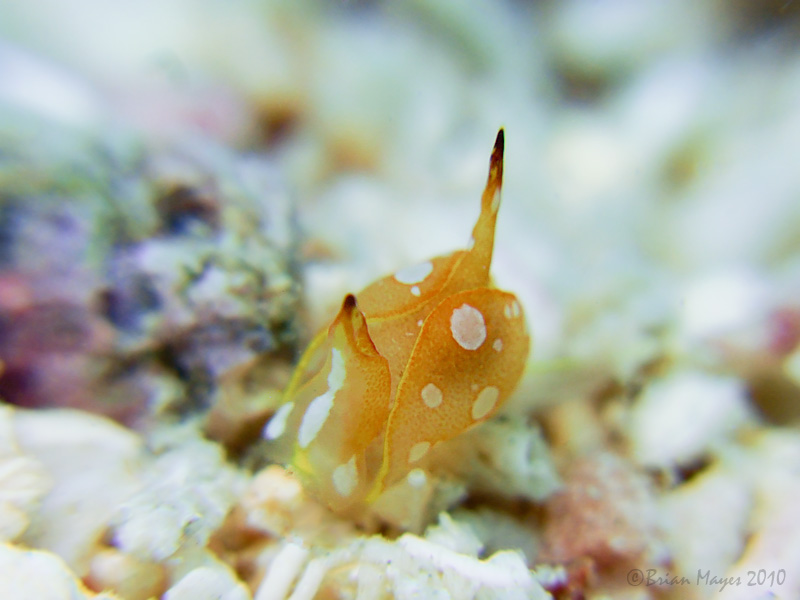 |
Siphopteron c.f. citrinum??
Image courtesy of Brian MayesPerhentians, North East Malaysia
Estimated size 5mm, depth 15 metres.
Well here's one of those dilemmas that keeps us thinking and hunting for answers. Brian Mayes sent us this photo quite a ways back. I wasn't sure what it was, or if it was new. My conservative guess was a Siphopteron citrinum with white spots. Mike sent the photo on to Clay and Patty Jo, the authors of S. citrinum, for their look see, and call. Clay's initial call - "The beast looks like an 'off color' form of Siphopteron ladrones. - not sure re the length of the posterior projection, though we have not photographed a massive number to see how much this may vary." Thanks Clay. Personally I would never have called it S. ladrones, but Clay and Patty Jo are the experts on this group. So that said - upon a second inspection, the foot more closely matches S. Ladrones than S. citrinum, while the dorsal projections more closely compare with those of S. citrinum. Indo-Pacific Nudibranchs and Sea Slugs. reports a medial orange line on the head of S. ladrones, which is absent, in Brian's frontal shot. Is that yellow patch on the head, the described medial line, or is the broader, longer white line on the head shield what was originally described for this species? Got to admit, those white spots on an orange background are a compelling argument for S. ladrones .
As with a lot of other slug identification attempts, it looks like this one will remain indeterminate for the time being. Clay and Patty Jo have responded in conclusion that the subject doesn't match any of the S. citrinum variations they have on file so they are more comfortable at the present time with just leaving it as Siphopteron sp.
What do you as the reader think? Drop us an email!
Send Dave email at dwbehrens@comcast.net
Gig Harbor, Washington
Nov., 2010
Brian Mayes
 |
Brian is a former finance director, who retired early to spend more time traveling and diving with his lovely wife Jill. He trained to dive in 1990 with the British Sub-Aqua Club (BSAC) where he met and married Jill, his dive buddy and ace spotter. After a few years of dry suit diving in the cold seas around the British Isles, he decided that he had seen enough rusty scrap metal (or wrecks as they are commonly known) and started diving coral reefs. In warm tropical waters Brian soon discovered an interest in the brightly coloured marine life and wanted to find out more about the things he had seen. In 1993, Brian acquired his first underwater camera, a Nikonos V and began snapping away at anything that didn't move too fast, like nudibranchs and flatworms. Pretty soon Brian was hooked on underwater macro photography and he (well Jill actually) has discovered a few new species and range extensions. However, since no specimens were collected the fame and the glory has so far eluded him. Though Brian's not sure he could kill a few critters just to get his name on it. When digital cameras came along, Brian upgraded to a Nikon Coolpix 990 in Ikelite housing with Ikelite Pro Video-Lite, but he found that this large setup weighing 9Kg was too awkward and heavy. Brian now prefers to use small compact cameras and currently uses a Canon G9 with a couple of Inon macro close-up lens, but no external strobe, only the internal flash and diffuser. Brian's photos from recent dive trips can be seen here Send Brian email at brian.r.mayes@gmail.com |

|
